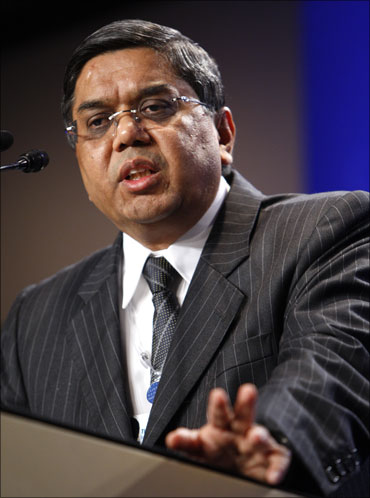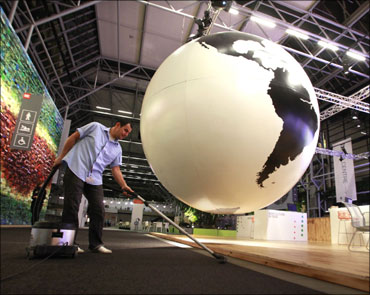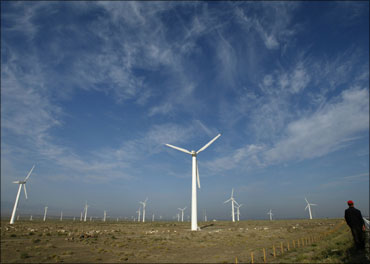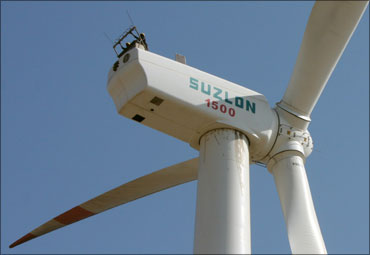
After a rough spell that saw company debt rise to a high of Rs 12,000 crore (Rs 120 billion) and stock valuation drop, the world's third-largest wind turbine company, Suzlon, is looking forward to renewed and rapid growth.
Chairman Tulsi Tanti spoke to Business Standard at a recent World Economic Forum conference in Brussels about his view on a post-Copenhagen environment for wind and why green growth and development are complementary rather than contradictory. Edited excerpts:
Does high debt continue to be a big worry for Suzlon?
We have repaid $780 million of our debt through refinancing from Indian banks and also by selling a stake we had in Hansen Transmissions in Belgium. This has brought down our debt levels by 15 per cent.
So, the process of refinancing our debt structure has now been completed. We took on the debt for two reasons. For capex, and we also made two large acquisitions -- Hansen in Belgium and REpower in Germany. Also, since we are in a highly capital-intensive business, we need more working capital.
This explains the debt. It is our company's policy to keep debt-equity ratio at 1:1. Currently, we are at 1:1.5. But after the capital restructuring that we are doing, this ratio will come down to 1:0.9, because we have convertible bonds and some of the promoter loans will be converted into equity in the future. We are quite comfortable.
. . .

What is your take on the outcome of the global climate meet at Copenhagen in December?
We strongly believe a global framework for climate change is necessary. We need more clarity, so that long-term investments can be planned and, accordingly, we can reset our power sector to bring in more and more renewables.
I think Copenhagen was a partial success. There was no legally-binding consensus, which is a pity. But, there were two successful outcomes.
One, all 192 countries agreed to keep the temperature of the earth below 2 degrees, which shows a good mutual understanding.
Two, the Reducing Emissions from Deforestation and Degradation (REED) agreement on preventing deforestation was brought out.
But, without a common legally-binding agreement, renewables will not get the global push they need.
What do you make of India's changing stance on the climate change question? Are you heartened by the more aggressive stance recently taken?
India is doing a great job. The prime minister has set a target of 15 per cent renewables by 2020, which is a good target. The current installation of 12 giga watt (GW) of wind in India represents good growth.
Every year, India is adding approximately 1 to 2GW, so whatever new energy is generated, renewables contribute some 20 per cent to it.
. . .

How would you compare this to growth in China?
China is growing much more aggressively. India has 12 GW in all, but China is adding 12 GW every year. They have a good framework plus a good execution capability.
We have been in China for the last five years and business is good. We have supplied nearly 700MW already, and we are planning to supply an additional 300-400MW this year.
It is often asked whether in a country like India, where basic development needs are still unaddressed, green growth should really be a priority. What is your view?
What Indian really needs is more energy. That is the basic need. Also, energy security is important for India. We need affordable, secure and low-cost energy, which can be sourced from renewables resources.
Moreover, wind creates green jobs. We should look to develop India as a hub of manufacturing for exports in India. So, there is no contradiction between green growth and development, and, in fact, renewables are a catalyst to stimulate economic growth.
. . .

How would you compare this to growth in China?
China is growing much more aggressively. India has 12 GW in all, but China is adding 12 GW every year. They have a good framework plus a good execution capability.
We have been in China for the last five years and business is good. We have supplied nearly 700MW already, and we are planning to supply an additional 300-400MW this year.
It is often asked whether in a country like India, where basic development needs are still unaddressed, green growth should really be a priority. What is your view?
What Indian really needs is more energy. That is the basic need. Also, energy security is important for India. We need affordable, secure and low-cost energy, which can be sourced from renewables resources.
Moreover, wind creates green jobs. We should look to develop India as a hub of manufacturing for exports in India. So, there is no contradiction between green growth and development, and, in fact, renewables are a catalyst to stimulate economic growth.
. . .

How do you see the technology of wind energy evolving going forward?
Technology will evolve differently in different markets according to different needs. In the Asian market, for instance, big volume and low-cost turbines are the main requirements.
But, when it comes to the European market, there are very large turbines of 3-6 MW, with a tower height of 80-100 metres. Plus there are more and more offshore projects of 5-6 MW. In REpower, this is what we are producing: the largest wind turbines in the world. Overall, the focus of technology is on reducing the cost of power per Kilo Watt hour (KWh).
In Suzlon, we have a target to reduce the cost per KWh by 15 per cent over the next five years, so that wind becomes increasingly affordable.
When do you see wind energy and conventional energy reaching cost parity?
I think in some markets it has already been achieved, wind being very competitive. But, when one compares wind with coal, one has to add the cost of carbon.
So, if you are comparing a coal-based power plant to the wind one, this is not an apple to apple comparison. If you add the price of carbon, wind has the same price as that of coal.
In any case, among renewables, wind is quite competitive since it's growing larger and larger in scale. We strongly believe that in the next 10 years, wind will directly compete with coal, even without the value of carbon being added.
. . .

Where do you see your main growth coming from?
From the Asian markets. In Europe, growth is moderate or flat at the moment, but within Europe some high growth in the next five years will come from offshore wind projects.
The US has negative growth at present. However, in the next five years, total global wind growth will be 20-25 per cent.
How does Suzlon distinguish itself from its competitors?
Within the market place, we are well-positioned due to our competitive edge, since we have all the range of products, from small to large turbines and also offshore ones.
Also, we are present in 24 countries, and finally, our business model is of an end-to-end solution provider. We are providing long-term operational maintenance service for for the entire life of the turbine. Moreover, we are only focused on wind turbines. If you take GE or Siemens, they have other businesses; but we are solely focused on wind power.
. . .